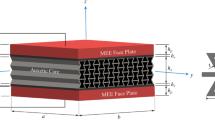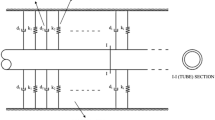Abstract
A cyclic coupling computational model is developed to investigate the large deformation of swollen red blood cells (RBCs) induced by the acoustic radiation force arising from an ultrasonic standing wave field. The RBC consists of an internal fluid enclosed by a thin elastic membrane. Based on the acoustic radiation stress tensor theory, the acoustic radiation force exerted on the cell membrane is calculated. A continuum mechanical theory is adopted to model the mechanical response of the membrane, which is capable of accounting for the in-plane and bending deformation of the cell membrane. The cyclic coupling computation of the acoustic fields and mechanical deformation is realized in a finite element model. With the developed model, the acoustic deformation of a single cell is calculated and results are compared with the semi-analytical solutions for validation purposes. Then, the multiple cell deformation is considered, showing that the multiple cell deformation is influenced by the secondary acoustic radiation force arising due to cell–cell interaction. This work provides an accurate numerical approach to predict the acoustic deformability of cells, which might help explore the application of the ultrasonic technique in disease diagnosis and in promoting stem cell differentiation.








Similar content being viewed by others
References
Bagchi P, Johnson PC, Popel AS (2005) Computational fluid dynamic simulation of aggregation of deformable cells in a shear flow. J Biomech Eng Trans ASME 127(7):1070–1080
Breyiannis G, Pozrikidis C (2000) Simple shear flow of suspensions of elastic capsules. Theor Comput Fluid Dyn 13(5):327–347
Bruus H (2012) Acoustofluidics 7: the acoustic radiation force on small particles. Lab Chip 12(6):1014–1021
Campbell EJ, Bagchi P (2018) A computational model of amoeboid cell motility in the presence of obstacles. Soft Matter 14(28):5741–5763
Chien S, Sung KLP, Skalak R, Usami S (1978) Theoretical and experimental studies on viscoelastic properties of erythrocyte membrane. Biophys J 24(2):463–487
Chowdhury F, Na S, Li D, Poh YC, Tanaka TS, Wang F, Wang N (2010) Material properties of the cell dictate stress-induced spreading and differentiation in embryonic stem cells. Nat Mater 9(1):82–88
Dziuk G (2008) Computational parametric Willmore flow. Numer Math 111(1):55–80
Evans EA, Lacelle PL (1975) Intrinsic material properties of the erythrocyte membrane indicated by mechanical analysis of deformation. Blood 45(1):29–43
Flormann D, Aouane O, Kaestner L, Ruloff C, Misbah C, Podgorski T, Wagner C (2017) The buckling instability of aggregating red blood cells. Sci Rep 7:10
Gossett DR, Tse HTK, Lee SA, Ying Y, Lindgren AG, Yang OO, Rao JY, Clark AT, Di Carlo D (2012) Hydrodynamic stretching of single cells for large population mechanical phenotyping. Proc Natl Acad Sci U S A 109(20):7630–7635
Guck J, Ananthakrishnan R, Mahmood H, Moon TJ, Cunningham CC, Kas J (2001) The optical stretcher: a novel laser tool to micromanipulate cells. Biophys J 81(2):767–784
Guckenberger A, Gekle S (2017) Theory and algorithms to compute Helfrich bending forces: a review. J Phys Condes Matter 29(20):30
Hochmuth RM (2000) Micropipette aspiration of living cells. J Biomech 33(1):15–22
Hong ZY, Xie WJ, Wei B (2010) Interaction of acoustic levitation field with liquid reflecting surface. J Appl Phys 107(1):4
Kamruzzahan ASM, Kienberger F, Stroh CM, Berg J, Huss R, Ebner A, Zhu R, Rankl C, Gruber HJ, Hinterdorfer P (2004) Imaging morphological details and pathological differences of red blood cells using tapping-mode AFM. Biol Chem 385(10):955–960
Koch M, Wright KE, Otto O, Herbig M, Salinas ND, Tolia NH, Satchwell TJ, Guck J, Brooks NJ, Baum J (2017) Plasmodium falciparum erythrocyte-binding antigen 175 triggers a biophysical change in the red blood cell that facilitates invasion. Proc Natl Acad Sci U S A 114(16):4225–4230
Laadhari A, Misbah C, Saramito P (2010) On the equilibrium equation for a generalized biological membrane energy by using a shape optimization approach. Phys D 239(16):1567–1572
Lee J, Shung KK (2006) Radiation forces exerted on arbitrarily located sphere by acoustic tweezer. J Acoust Soc Am 120(2):1084–1094
Lee CP, Wang TG (1993) Acoustic radiation pressure. J Acoust Soc Am 94(2):1099–1109
Li J, Dao M, Lim CT, Suresh S (2005) Spectrin-level modeling of the cytoskeleton and optical tweezers stretching of the erythrocyte. Biophys J 88(5):3707–3719
Mauritz JMA, Tiffert T, Seear R, Lautenschlager F, Esposito A, Lew VL, Guck J, Kaminski CF (2010) Detection of Plasmodium falciparum-infected red blood cells by optical stretching. J Biomed Opt 15(3):030517
Mietke A, Otto O, Girardo S, Rosendahl P, Taubenberger A, Golfier S, Ulbricht E, Aland S, Guck J, Fischer-Friedrich E (2015) Extracting cell stiffness from real-time deformability cytometry: theory and experiment. Biophys J 109(10):2023–2036
Mishra P, Hill M, Glynne-Jones P (2014) Deformation of red blood cells using acoustic radiation forces. Biomicrofluidics 8(3):11
Olofsson K, Carannante V, Ohlin M, Frisk T, Kushiro K, Takai M, Lundqvist A, Onfelt B, Wiklund M (2018) Acoustic formation of multicellular tumor spheroids enabling on-chip functional and structural imaging. Lab Chip 18(16):2466–2476
Omori T, Ishikawa T, Imai Y, Yamaguchi T (2013) Membrane tension of red blood cells pairwisely interacting in simple shear flow. J Biomech 46(3):548–553
Pajerowski JD, Dahl KN, Zhong FL, Sammak PJ, Discher DE (2007) Physical plasticity of the nucleus in stem cell differentiation. Proc Natl Acad Sci U S A 104(40):15619–15624
Palmeri ML, Sharma AC, Bouchard RR, Nightingale RW, Nightingale KR (2005) A finite-element method model of soft tissue response to impulsive acoustic radiation force. IEEE Trans Ultrason Ferroelectr Freq Control 52(10):1699–1712
Quaife B, Veerapaneni S, Young YN (2019) Hydrodynamics and rheology of a vesicle doublet suspension. Phys Rev Fluids 4(10):23
Rodrigues DS, Ausas RF, Mut F, Buscaglia GC (2015) A semi-implicit finite element method for viscous lipid membranes. J Comput Phys 298:565–584
Shi JJ, Ahmed D, Mao X, Lin SCS, Lawit A, Huang TJ (2009) Acoustic tweezers: patterning cells and microparticles using standing surface acoustic waves (SSAW). Lab Chip 9(20):2890–2895
Shortencarier MJ, Dayton PA, Bloch SH, Schumann PA, Matsunaga TO, Ferrara KW (2004) A method for radiation-force localized drug delivery using gas-filled lipospheres. IEEE Trans Ultrason Ferroelectr Freq Control 51(7):822–831
Silva GT, Tian LF, Franklin A, Wang XJ, Han XJ, Mann S, Drinkwater BW (2019) Acoustic deformation for the extraction of mechanical properties of lipid vesicle populations. Phys Rev E 99(6):10
Suresh S, Spatz J, Mills JP, Micoulet A, Dao M, Lim CT, Beil M, Seufferlein T (2005) Connections between single-cell biomechanics and human disease states: gastrointestinal cancer and malaria. Acta Biomater 1(1):15–30
Vlahovska PM, Young YN, Danker G, Misbah C (2011) Dynamics of a non-spherical microcapsule with incompressible interface in shear flow. J Fluid Mech 678:221–247
Wei W, Thiessen DB, Marston PL (2004) Acoustic radiation force on a compressible cylinder in a standing wave. J Acoust Soc Am 116(1):201–208
Wiggins P, Phillips R (2005) Membrane-protein interactions in mechanosensitive channels. Biophys J 88(2):880–902
Wijaya FB, Mohapatra AR, Sepehrirahnama S, Lim KM (2016) Coupled acoustic-shell model for experimental study of cell stiffness under acoustophoresis. Microfluid Nanofluid 20(5):15
Xin FX, Lu TJ (2016) Acoustomechanical constitutive theory for soft materials. Acta Mech Sin 32(5):828–840
Ye T, Nhan PT, Khoo BC, Lim CT (2013) Stretching and relaxation of malaria-infected red blood cells. Biophys J 105(5):1103–1109
Zhang BY, Korolj A, Lai BFL, Radisic M (2018) Advances in organ-on-a-chip engineering. Nat Rev Mater 3(8):257–278
Acknowledgements
This work was supported by the National Natural Science Foundation of China (11772248, 52075416 and 11761131003) and the Fundamental Research Funds for the Central Universities.
Author information
Authors and Affiliations
Corresponding author
Ethics declarations
Conflict of interest
The authors declare no competing financial interests.
Additional information
Publisher's Note
Springer Nature remains neutral with regard to jurisdictional claims in published maps and institutional affiliations.
Appendix: comparison of acoustic radiation stress distribution in 2D and 3D
Appendix: comparison of acoustic radiation stress distribution in 2D and 3D
Denoting the density contrast between the cell and the medium as \(\tilde{\rho } = {{\rho_{i} } \mathord{\left/ {\vphantom {{\rho_{i} } {\rho_{o} }}} \right. \kern-\nulldelimiterspace} {\rho_{o} }}\), the jump of normal acoustic radiation stress acting on the cell membrane in Eq. (26) can be written as
Here, the superscript “2D” is added to highlight that this formula is derived for 2D cells. The corresponding expression of 3D cells has been derived by Silva et al. (2019) and is given by
Here, the angle \(\theta\) for 2D and 3D cases are defined so that the direction \(\theta = {{\uppi } \mathord{\left/ {\vphantom {{\uppi } 2}} \right. \kern-\nulldelimiterspace} 2}\) is consistent with the acoustic wave propagation direction, as shown in Fig.
9.
For the low-density contrast between the cell and the surrounding medium, we Taylor expand the above expressions of \(f_{n}^{a,2D}\) and \(f_{n}^{a,3D}\) and find
This consistency shows that when the acoustic contrast between the cell and the surrounding medium is low, the acoustic radiation stress distribution in 2D and 3D can be exactly the same.
Rights and permissions
About this article
Cite this article
Liu, Y., Xin, F. Characterization of red blood cell deformability induced by acoustic radiation force. Microfluid Nanofluid 26, 7 (2022). https://doi.org/10.1007/s10404-021-02513-z
Received:
Accepted:
Published:
DOI: https://doi.org/10.1007/s10404-021-02513-z





